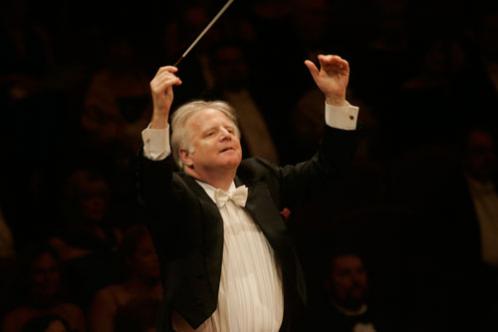Welcome to the 79th work in the Slipped Disc/Idagio Beethoven Edition
Seventh symphony, opus 92 (part 2)
In continuing our discussion of this under-discussed work, I have asked Leonard Slatkin to explain it from the conductor’s viewpoint. Leonard is former music director in St Louis, London, Washington DC, Lyon and Detroit.
What the Seventh Tells Us
By Leonard Slatkin
Ask any conductor what the first Beethoven Symphony they ever led was, and the response is more than likely to be the Seventh. Why is that?
In many ways, this is the least difficult technically to direct. Other than the transition into the Allegro of the first movement and figuring out what to do about the tempo of the trio, the physical act of conducting is not nearly as complicated as in the other works. Even many of the decisions regarding phrasing are fairly straightforward.
What makes a good performance of this work has to do with how the myriad details are presented. Even more important, as with virtually all symphonies, is the ability for the conductor to give each movement a well thought out sense of the architecture. Has the journey felt complete?
The choices about length of notes, articulation and balance are critical to make a really outstanding performance. Even the first chord is up for grabs. Is it short and aggressive or longer and noble? In the introduction, can we always sustain the main tune with all those semi-quavers going on at the same time? Is the upbeat to the Allegro in the tempo of the introduction or the same as what occurs next?
The main body of the movement has one of Beethoven’s trickiest rhythms to bring off successfully. It is usually notated as a quaver, followed by a semi-quaver rest and then another quaver in the 6/8 meter. This is same rhythm that the timpani plays in the Scherzo of the Ninth. In fact, I always tell the orchestra to think of that instrument in order to play it correctly. Just think tim-pani, tim-pani and you will get the idea.
There is always controversy about the tempo of the 2nd movement. Notice that I did not call it the slow movement. After all, it is marked Allegretto. Every conductor I know has struggled with this and changed their minds over and over. George Szell called this, along with the 2nd movement of the Schubert Ninth, the two most difficult pieces to start conducting. There was a time when it was performed regularly as a funereal work, even today sometimes played as a memorial. Current thinking has moved most interpreters to a more forward moving tempo, but there still needs to be dignity.
What to do about those repeats in the Scherzo? Again, each of us changes our mind as we want to be faithful to what Beethoven wrote. but it can sometimes be a bit boring to perform the same music three times. And the equivalent problem pops up again in the Finale. The metronome marking is on the fast side and once in a while we are confronted with the possible lack of technical finesse to make it work with some orchestras. Plus, the acoustics of the environment can also force us into a compromise as regards the speed.
I will not get into matters of adjusting for balances, where the winds and strings need to take breaths, or how loud the triple fortes really should be. This is the first time the composer utilized that dynamic. Therefore, should all the double fortes that precede it be of lesser volume? Choices, choices, choices.
My selections for “best” recordings are incomplete by necessity. I have not heard every performance so more than likely left many behind. But the ones that I chose are those that caught my attention and made me want to hear them again. If you want to know my own personal taste in this masterpiece, you would have to obtain the recording I made with the Detroit Symphony (not on Idagio or Youtube). Does it match up to the ones I selected. No. But it is not bad.

*
Thanks for that, Leonard. Before we move into a consideration tomorrow of the outstanding records of all time, here are a couple of nuggest from the Idagio archives.
Richard Strauss conducting the finale in Berlin, 1922, with astonishing poise and momentum.
Willem Mengelberg in Amsterdam, 1940, immeasurably individualist, uncontainably awkward.
George Szell‘s earlier recording, in 1943, with a New York Philharmonic trained to within an inch of their lives. Quite horrible at times.
King Frederick of Denmark, who conducted like … a king.
And this absolute rarity: Herbert von Karajan conducting the opera orchestra in Berlin in 1941, a time that Wilhelm Furtwängler was using all his influence with the Nazis to get the young contender on a train out of town, preferably to somewhere near a war front. Karajan directs this symphony with panache bordering on insouciance, as if he hadn’t a care in the world. The performance exists almost out of time. Where, with Furtwängler, you cannot fail to be aware there’s a war going on, with Karajan this could be a stroll with a girlfriend in the park. The second movement is romantic, never ominous, and the finale is magnificence itself. You wll come away from this thinking better of Karajan. Myself, I’d recommend this as his most personal, most polished, Beethoven recording.
More tomorrow.
"difficult" - Google News
June 06, 2020 at 05:27AM
https://ift.tt/309IUGN
The most difficult movement to start conducting - Slipped Disc
"difficult" - Google News
https://ift.tt/2VWzYBO
https://ift.tt/3d5eskc
Bagikan Berita Ini















0 Response to "The most difficult movement to start conducting - Slipped Disc"
Post a Comment